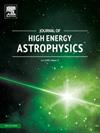在q(t)参数化模型中提取H0和rd
IF 10.5
4区 物理与天体物理
Q1 ASTRONOMY & ASTROPHYSICS
引用次数: 0
摘要
本研究探索了哈勃参数(H)的Pacif参数化方案衍生的五个模型,它们代表了减速参数(DP)的不同形式。我们的主要目标是确定每个模型的哈勃常数(H0)和声视界(rd)的参数分布。此外,我们分析了DP在每种情况下的演化,以评估其对后期宇宙演化的影响。在我们的分析中,我们将rd视为一个自由参数,这使我们能够避免依赖于关于早期宇宙物理和重组模型的特定假设。这种方法确保了早期宇宙侧模型的独立性,并使后期宇宙学观测能够直接约束rd和其他关键参数。为了提取Pacif方案的参数分布,我们结合了重子声学振荡(BAO)数据、宇宙天文钟(CC)数据、Ia型超新星(SNe Ia)数据、伽马射线暴(GRBs)数据和类星体数据。我们的结果得到了H0和rd的后验分布,这与普朗克CMB数据有显著的一致性。利用赤池信息准则(Akaike Information Criterion, AIC)对模型进行了评价,发现5个模型均与最新观测数据具有较好的一致性。本文章由计算机程序翻译,如有差异,请以英文原文为准。
Extracting H0 and rd in q(t) parametrization models
This study explores five models derived from the Pacif parameterization scheme of the Hubble parameter (H), which represent different forms of the deceleration parameter (DP). Our primary objective is to determine the parameter distributions of the Hubble constant () and the sound horizon () for each model. Additionally, we analyze the evolution of the DP in each scenario to assess its implications for late-time cosmic evolution. In our analysis, we treat as a free parameter, which allows us to avoid relying on specific assumptions about early-Universe physics and recombination models. This approach ensures model independence on the early-Universe side and enables late-time cosmological observations to directly constrain alongside other key parameters. To extract the parameter distributions for the Pacif scheme, we use a combination of Baryon Acoustic Oscillation (BAO) data, Cosmic Chronometers (CC), Type Ia Supernovae (SNe Ia), Gamma-Ray Bursts (GRBs), and Quasars. Our results yield posterior distributions for and , which demonstrate notable consistency with the Planck CMB data. Using the Akaike Information Criterion (AIC), we evaluate the models, finding that all five models provide robust agreement with the latest observational data.
求助全文
通过发布文献求助,成功后即可免费获取论文全文。
去求助
来源期刊

Journal of High Energy Astrophysics
Earth and Planetary Sciences-Space and Planetary Science
CiteScore
9.70
自引率
5.30%
发文量
38
审稿时长
65 days
期刊介绍:
The journal welcomes manuscripts on theoretical models, simulations, and observations of highly energetic astrophysical objects both in our Galaxy and beyond. Among those, black holes at all scales, neutron stars, pulsars and their nebula, binaries, novae and supernovae, their remnants, active galaxies, and clusters are just a few examples. The journal will consider research across the whole electromagnetic spectrum, as well as research using various messengers, such as gravitational waves or neutrinos. Effects of high-energy phenomena on cosmology and star-formation, results from dedicated surveys expanding the knowledge of extreme environments, and astrophysical implications of dark matter are also welcomed topics.
 求助内容:
求助内容: 应助结果提醒方式:
应助结果提醒方式:


